Lawrence Muhwezi, Alfred Alexis Abonga, Ruth Sengonzi
Department of Civil and Building Engineering, Kyambogo University, Kampala, Uganda
Correspondence to: Lawrence Muhwezi, Department of Civil and Building Engineering, Kyambogo University, Kampala, Uganda.
| Email: |  |
Copyright © 2020 The Author(s). Published by Scientific & Academic Publishing.
This work is licensed under the Creative Commons Attribution International License (CC BY).
http://creativecommons.org/licenses/by/4.0/

Abstract
The government of Uganda has put in place plans for road development and maintenance and has improved on its budget allocations in order to boost tourism, agriculture and mining among others. However, road maintenance remains a challenge due to cost deviations, inflation of unit costs by contractors and delays in maintenance interventions. This study examined cost performance improvement of unpaved road maintenance projects in Northern Uganda considering a case of Uganda National Roads Authority (UNRA). The main objective was to develop a model for cost performance improvement in unpaved road maintenance projects. The study was conducted in four UNRA stations in Northern Uganda, namely Arua, Gulu, Kitgum and Moyo Stations which were purposively sampled. Both qualitative and quantitative data were collected, using survey questionnaires and documentary reviews. Data were analyzed using correlations, regression and descriptive analysis. The findings indicated that the budgets reviewed for wearing course/shoulder and drainage improvements experienced negative cost deviations from original budgets. Material price fluctuations, shortages, late deliveries, equipment availability and failures were key factors found to contribute significantly to cost deviations. The developed model shall be used in accurate estimation of maintenance project costs, hence contributing to road maintenance cost performance improvement.
Keywords:
Project cost, Cost deviations, Road maintenance, Performance
Cite this paper: Lawrence Muhwezi, Alfred Alexis Abonga, Ruth Sengonzi, Factors Influencing Cost Performance of Unpaved Road Maintenance Projects in Uganda, International Journal of Construction Engineering and Management , Vol. 9 No. 1, 2020, pp. 1-10. doi: 10.5923/j.ijcem.20200901.01.
1. Introduction
Investments in infrastructure are crucial drivers of economic growth and development according to Sustainable Development Goal number 9. Poor maintenance of roads constrains mobility and significantly raises vehicle operating costs. Moreover, it increases accident rates and their human and property associated costs. Poor road maintenance is also known to aggravate isolation, poverty, poor health and illiteracy in rural communities (Burnigham and Stankevic, 2005). Maintenance of roads is an essential function which should be carried out on a timely basis (PIARC, 1994). With competitive utilization of scarce public resources by various sectors, there is need to improve on maintenance cost in order to realize savings and do more maintenance work with the savings. The study focused on completed periodic road maintenance projects implemented by Uganda National Roads Authority in order to obtain data on cost deviations from project documents. The collected data were used to develop a model that shall be used to improve cost deviations in road maintenance projects by predicting whether a maintenance project cost is likely to deviate or not during preparation of project budgets.
2. Literature Review
2.1. Project Cost
This refers to a detailed time phased estimate of all resource costs for a project (Al-Agele and Al-Hassan, 2016). Project resources are not always enough and there is usually a limited budget which must be allocated to all project activities (Scot and Jefferson, 2007). Project cost is best calculated at a time when little is known about a project (Atkinson, 1999). Management of project cost includes processes involved in estimating, budgeting and controlling the costs so that it can be completed within approved budget (PMBOK, 2013). Project managers are supposed to make sure that projects they approve are well defined with accurate time and cost estimates and a realistic budget. Project costs are estimated by predicting quantities, unit costs and or prices of resources required by the scope of the project (WSDT, 2015). They could also be estimated by developing approximate likely cost of resources, including inflation allowance and contingency costs necessary to complete project activities (PMBOK, 2013). The project cost estimates are then aggregated to become a budget which can be used for measuring and monitoring cost performance. Project cost must be controlled to ensure that projects are implemented within their budgets on time and in correct quality (Al-Agele and Al-Hassan, 2016). There are two control techniques established to control project costs namely: budgetary control and standard costing. Budgetary control is where a budget is used as a means of planning and controlling entire aspects of organization activities. Standard costing, however, is a system of control aimed at establishing standards of performances and target costs to be achieved under a given set of working conditions (Chan, 2014). Similarly, project cost control entails monitoring and controlling changes to a project budget through being concerned with key factors that cause the changes to the budget and actual controlling of project cost changes as they occur (Guo-Li, 2010). The study explains further that actual project cost changes are controlled through monitoring cost performances to detect variances, accurately recording appropriate changes in the cost baseline, preventing un authorized changes being included in the cost baseline, determining positive and negative variances and integrating it with all other control processes. If an organization is able to forecast accurately cost performances then it can confidently allocate capital, hence reducing financial risk (Pennypacker, 2005).
2.2. Cost Deviations
Cost deviation may be expressed as a percentage difference between the final cost of a project (actual cost) and the contract award amount (estimated cost). Cost deviations in construction projects have been noted to be a widespread problem affecting construction industry globally irrespective of the value of the project (Mahamid and Amund, 2012). A study of 169 road construction projects in West Bank in Palestine indicated that 76% of the projects were underestimated (negative deviation) whereas 24% were overestimated (positive deviation). Cost deviations arise, among others, as a result of price escalations (Omoregie and Radford, 2006). Frequent change orders, lack of experience and lack of communication with suppliers were the major causes of cost deviations in highway construction projects in Bahrain (Ahmed et. al., 2014), whereas corruption, delays in progress payments by clients, difficulties in financing projects by contractors, security and change orders by clients were major causes in Afghanistan (Abbas & Painting, 2016). Physical characteristics were established to have effects on cost deviations of road construction (Mahamid and Amund, 2012). In Egypt, factors causing cost variations were identified, ranked and grouped in order of influence under the following categories: owner originated category, designer originated category, contractor originated category and miscellaneous category (Aziz, 2013). In Malaysia, factors causing cost overruns in large construction projects were grouped and validated into 7 categories namely: contractor site management-related factors, design and documentation-related factors, financial management-related factors, Information communication and technology related-factors, labour management-related factors, material and machinery-related factors and project management and contract administration-related factors (Rahman et. al., 2013). Regional differences with respect to magnitude of cost deviations have been established to exist (Odeck, 2004). Al-Agele and Al-Hassan, (2016) assessed 16 factors responsible for cost deviations in construction work in Iraq after a study of eight different completed projects as accepting lowest offers, inadequate planning and delayed cash flows by owners. This was similar to the findings by Ahmed et. al., (2014). Oguya and Muturi, (2016) established contractor’s competency, construction parties financial management, timely availability of construction resources and conflicts, as the major factors affecting performances of road projects in arid and semi-arid areas of Kenya. Whereas Alinaitwe et. al., (2013) investigated and established that changes to the scope of work, delayed payments, poor monitoring and control, high cost of capital and political instability were the major factors contributing to construction delays and cost overruns in Uganda. In addition, Otim et. al., (2011) established that the following difficulties exist in controlling cost in construction projects: delays in paying contractors, delays in decision making and lack of materials and equipment among others.
2.3. Road Maintenance
Road maintenance refers to interventions or works required to keep a road, its structures and property within the road margins as near as possible to their as-constructed or rehabilitated condition (World Bank, 2005). Principally, an unpaved road has the following basic elements: road reserve, formation width, road surface, carriage way, road shoulders, gravel pavement, subgrade surface and road drains and drainage structures (MoWT Technical Manual, 2004).Maintenance interventions which are categorized as Routine, Periodic and Emergency maintenances are meant to keep these elements in good conditions. The focus of this research was on periodic maintenance of unpaved roads covering works on the road subgrade, gravel pavement and road drainages undertaken through use of contractors. In Uganda, the Uganda National Roads Authority (UNRA) is responsible for development and maintenance of all national road networks linking one district to another. All the reviewed literature focused mainly on cost deviations on new road construction projects which are either paved road projects or other construction projects. Major causes of cost deviations in unpaved road projects have not yet been adequately studied in Uganda, although the sector is currently experiencing challenges in maintenance of unpaved roads countrywide.Therefore, having noted the above information gap, the study was carried out to establish the major causes of cost deviations in maintenance of unpaved roads in Northern Uganda, the findings were used to develop a model that could contribute to improvement of cost performance of unpaved road maintenance projects in Uganda.
3. Methodology
The study adopted a case study design to investigate in detail the variables under study in UNRA Stations. The case study approach allows the use of both quantitative and qualitative data analysis (Zainal, 2007). The study used both qualitative and quantitative approaches. The quantitative approach was adopted because the study intended to establish the factors that influence cost performances of road maintenance projects at the UNRA Stations. The quantitative approach was thought to be best suited for this study because it allows for collecting numeric data on observable individual behavior of samples, then subjecting this data to statistical analysis (Amin, 2005). The study also used a qualitative research approach in order to enable the researcher capture data that were left out by the quantitative approach. Study population comprised 32 respondents, with engineering training background, consisting of 4 Station Managers, 12 maintenance engineers and 16 maintenance technicians of UNRA, according to the staffing levels of the organization. All the projects considered were implemented through contracting undertaken through periodic or termed maintenance lasting from 1- 3years. The region of Northern Uganda was purposely selected because there is a lot of focus on infrastructural development and maintenance in the region after the two decades of insurgencies in the region that forced authorities to abandon maintenance of most road network infrastructures. UNRA was as well purposely selected based on the fact that they are the responsible authority for maintenance of national road network which is the most dominant means of transport. The road projects studied were, however, selected based on the type of maintenance interventions contracted out. Closed ended questionnaires were used to collect data and documents were also reviewed in order to obtain secondary data.
3.1. Data Collection
The study used the questionnaire method to collect data because it can collect data from a relatively large number of respondents from their natural settings. It is also cheap and saves time as suggested by Amin (2005). Questionnaires also allow busy respondents fill them at their convenient time in addition to allowing respondents express their views and opinions without fear of being victimized (Oso & Onen, 2008:18). The instrument used in this study was the questionnaire which was employed as a tool of primary data collection. Closed-ended questions were developed to help respondents make quick decisions; in addition, closed-ended questions helped the researcher to code the information easily for subsequent analysis and narrow down the error gap while analyzing data as observed by Sekaran (2003). All ethical considerations were applied in data collection.
3.2. Validity of the Data
To ensure validity, the developed sample questionnaires were administered to three (3) experts to score the relevance of each question in providing answers to the study. The experts included two (2) Station Managers and a Maintenance Engineer. These were purposively selected because they were believed to be knowledgeable about the topic under investigation. They ticked 25 out of 33 items in the questionnaires as relevant with respect to the causes of cost deviations. After the experts had scored the relevancy of the items in the research instrument, a content validity index (C.V.I) was computed using equation (1). | (1) |
A CVI of 0.7 and above is acceptable as suggested by Amin (2005). The number of respondents pre-tested was smaller, 10% of the sample size as suggested by Mugenda and Mugenda (1991). The researcher therefore used 3 respondents while pre-testing the instrument which represented 10% of the sample size of 32 respondents of the study. In this case, the CVI was obtained as 0.76, which was considered to be good enough to generate reliable results.
3.3. Reliability of the Data
To ensure reliability, a pre-test was done as a final study on 10% of the respondents. Data was coded and entered into the computer. Cronbach’s Alpha Reliability Coefficients were generated using computer program to estimate the reliability of the questionnaire. The Cronbach’s alpha reliability coefficient of 0.6 and above is acceptable (Sekaran, 2003). When Cronbach α is less than 0.3 it means the reliability is at low level; the data are therefore not reliable and cannot be accepted. Whereas a Cronbach α greater than 0.7 indicates that reliability is at high level (Rahman et. al., 2013). The response results were deemed to be reliable based on results in Table 1. Table 1. The reliability test results of the study
 |
| |
|
From table 1, the Cronbach Alpha Coefficient was 0.749 implying that the findings of the pilot study reflected that the study instruments were reliable.
3.4. Data Analysis
As mentioned before, the data collected through questionnaires was analyzed using SPSS version 21 because this is the most recommendable package for analyzing research data (Sekaran, 2013). The analysis relied on both descriptive and inferential statistics. The descriptive statistics used was frequency counts, percentages as well as the mean and standard deviation. Data on the respondent’s views and opinions about factors affecting cost performances was obtained using scaled variables from a self-developed questionnaire. A five point-Likert scale of 1= Not at all, 2= Small extent, 3= Moderate extent, 4= Large extent and 5= Very Large extent was used to tap respondents perception on the study variables.
4. Results and Analysis
A total of 32 questionnaires were distributed but 21 questionnaires were returned indicating a response rate of 65.6% as presented in Table 2. The results were representative of the survey on Cost Performance Improvement of unpaved road maintenance projects in Uganda considering a case of Uganda National Roads Authority.Table 2. Responses based on number of respondents
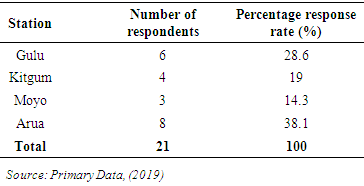 |
| |
|
4.1. Factors Influencing Cost Performances on Road Maintenance Projects
The highest number of respondents was from Arua UNRA station, 8 (38.1%). The second highest number of respondents were from Gulu UNRA station, 6 (28.6%) of the total respondents. This was followed by respondents from Kitgum UNRA station, with four respondents representing 19% of the total respondents. Only 3 respondents, representing 14.3% of the total respondents, were from Moyo UNRA station. From table 3, 11 (52.4%) of the respondents were Maintenance Technicians, followed by Maintenance Engineers who were 7 (33.3%) and the remaining respondents were Station Managers who totaled to only 3 respondents representing 14.3% of the total number of respondents. These results indicate that data were collected from a section of respondents believed to be knowledgeable about road maintenance works and therefore would lead to reliable dependable study findings.Table 3. Response rates based on titles of respondents
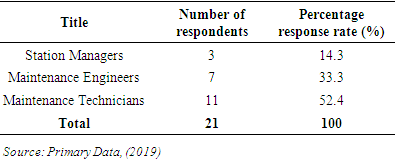 |
| |
|
From table 4, based on experiences in road maintenance with UNRA, 10 of the respondents representing 48% of the total number of respondents had worked for the organization for a period between 1 to 5 years. Six respondents, representing 28% of the total number of respondents, with working experience of 6 to 10 years. Besides, 4 respondents representing 19% of the total number of respondents had a working experience of between 11 to 15 years and finally the remaining 1 respondent representing 5% of the total number of respondents, had 16 to 20 years of experience. Therefore, the study findings are unbiased with regards to the distribution of respondents according to duty stations, designations and experiences in road maintenance works. Table 4. Experiences of respondents
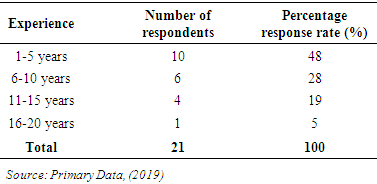 |
| |
|
4.2. Ranking of the Factors
A 5-point likert scale was used to score the identified factors that influence cost deviations in paved road maintenance works where: NA (1) = Not at All, SE (2) = Small Extent, ME (3) = Moderate Extent, LE (4) = Large Extent and VLE (5) = Very Large Extent. However, for purposes of interpretation note that scores for NA (Not at all) and SE (Small extent) are grouped to represent negligible influence while LE (large extent) and VLE (Very Large Extent) scores are grouped to represent respondents who believe that a factor strongly influences cost deviations. In addition, ME (Moderate Extent) represents respondents whose opinion was unclear whether the factor influences cost deviations or not. The Average Mean less than 3.00 was considered to represent scores of factors with negligible influence on cost deviation and those greater than 3.00 represent scores of factors with strong influence on cost deviation.
4.2.1. Contractors Site Management Factors
According to Table 5, a mean of 2.86 implied that majority of the respondents believed that poor site management and supervision had a negligible influence on cost deviation and was ranked in 5th position. A mean of 3.10 implied that majority of the respondents believed that inadequate planning and scheduling had a strong influence on cost deviation and was ranked in 3rd position. This is in agreement with findings by Al-Agele and Al-Hassan (2016) and Otim and Alinaitwe (2013).Table 5. Descriptive statistics of contractor’s site management
 |
| |
|
A mean of 2.81 implied that majority of the respondents believed that lack of experience had a negligible influence on cost deviation and was ranked in 6th position; a mean of 3.19 implied that majority of the respondents believed that inadequate time and cost estimate had a strong influence on cost deviation being ranked in 2nd position. Most contractors were established to have made a lot of inaccurate cost estimates. The finding is in agreement with findings of Ahmed et. al., (2014), Al-Agele and Al-Hassan (2016), Aziz (2013) and Omoregie & Radford (2016); a mean of 2.95 implied that majority of the respondents believed that mistakes during construction had a negligible influence on cost deviation and was ranked in 4th position; a mean of 3.24 implied that majority of the respondents believed that inadequate monitoring and control had a strong influence on cost deviation and was ranked first. It was established that most contractors are not adequately monitoring and controlling activities at the sites. As a result, there is low worker’s and equipment’s productivity leading to increase in labour payments and equipment hire costs with associated fuel and lubricant costs. This is in agreement with previous findings by Apolot et. al., (2013). Generally, the overall Average Means was 3.025 implying that majority of the respondents believed that the factor “Contractors Site Management” is one of the major factors that influence cost deviation within Road Maintenance Projects within Uganda National Roads Authority.
4.2.2. Design and Documentation Related Factors
From Table 6, a mean of 3.05 implied that majority of the respondents believed that frequent design changes had a strong influence on cost deviation and was ranked 2nd. These findings are in agreement with previous findings by Aziz (2013); Enhassi et. al., (2010); Omoregie and Radford (2006); Otim and Alinaitwe (2013); a mean of 3.00 implied that majority of the respondents believed that mistakes and errors in designs had a strong influence on cost deviation with a ranking of 3rd position; a mean of 3.10 implied that majority of the respondents believed that incomplete design at the time of tender had a strong influence on cost deviation and was ranked in 1st position. The finding is in agreement with previous findings by Chilese and Berko (2010) and Enhassi et. al., (2010); a mean of 3.00 implied that majority of the respondents believed that poor designs and delays in design had a strong influence on cost deviation with a ranking of 3rd position; a mean of 2.95 implied that majority of the respondents believed that delay preparations and approval of drawings had a negligible influence on cost deviation. Generally, the overall Average Mean was 3.02 implying that majority of the respondents believed that the factor design and documentation is one of the major factors that influence cost deviation within Road Maintenance Projects within Uganda National Roads Authority. Table 6. Descriptive statistics of Design and Documentation
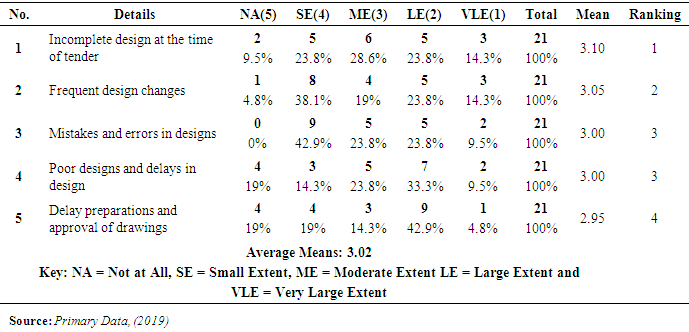 |
| |
|
4.2.3. Financial Management Factors
According to Table 7, a mean of 3.14 implied that majority of the respondents believed that cash flows and financial difficulties faced by contractors had a strong influence on cost deviation and ranked 4th. The finding is in agreement with previous finding by Al-Agele and Al-Hassan (2016); a mean of 3.10 implied that majority of the respondents believed that poor financial control on site had a strong influence on cost deviation and was ranked 5th. The finding is in agreement with findings by Oguya and Muturi (2016); a mean of 3.24 implied that majority of the respondents believed that financial difficulties of owners had a strong influence on cost deviation and ranked 3rd. This is in agreement with the findings of Tarimo (2017); a mean of 3.14 implied that majority of the respondents believed that delays in progress payments by owners had a strong influence on cost deviation and ranked 4th. This is in agreement with findings by Alinaitwe et. al., (2013) and Otim et. al., (2011); a mean of 3.29 implied that majority of the respondents believed that delay in payment to supplier/ contractor had a strong influence on cost deviation and ranked 2nd. Delay in payments to contractor was noted in studied projects under all the UNRA stations selected. The delays normally attract additional claims by contractors; a mean of 3.43 implied that majority of the respondents believed that contractual claim such as extension of time with claim had a strong influence on cost deviation and was ranked first. Generally, the overall Average Means was 3.223 implying that majority of the respondents believed that the factor Financial Management is one of the major factors that influence cost deviation within Road Maintenance Projects in Uganda National Roads Authority (UNRA).Table 7. Descriptive statistics of Financial Management
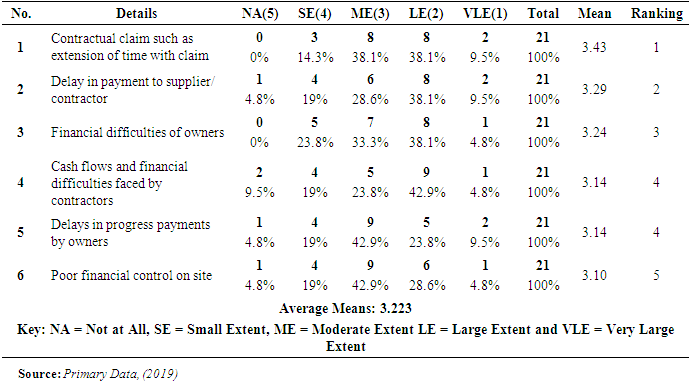 |
| |
|
4.2.4. Information and Communication Technology (ICT) Related Factors
From findings in Table 8, a mean of 2.57 implied that majority of the respondents believed that lack of coordination between parties had a negligible influence on cost deviation, though it was ranked in 2nd position; a mean of 2.57 implied that majority of the respondents believed that slow information flow between parties had a negligible influence on cost deviation, with a ranking of 2nd position; a mean of 2.71 implied that majority of the respondents believed that lack of communication between parties had a strong influence on cost deviation, being ranked in the 1st position. Generally, the overall Average Means was 2.62 implying that majority of the respondents believed that the factor Information and Communication Technology (ICT) is not among the major factors influencing cost deviation within Road Maintenance Projects in Uganda National Roads Authority. There is fairly good communication, coordination and information flow between contractors and the UNRA officers across all UNRA stations under the study. Although this is not in agreement with the findings of Rahman et. al., (2013).Table 8. Descriptive statistics of Information and Communication Technology
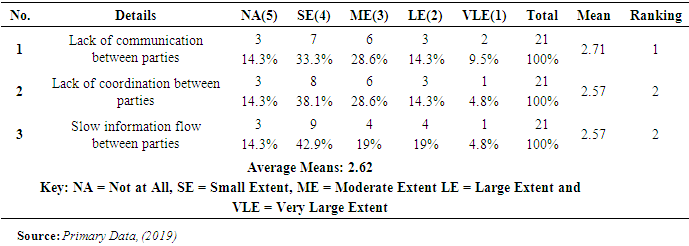 |
| |
|
4.2.5. Labour Management Related Factors
From Table 9, a mean of 3.43 implied that majority of the respondents believed that low labour productivity had a strong influence on cost deviation and was ranked 1st. The finding is in agreement with that of Rahman et al., (2013) and Chilese and Berko (2010); a mean of 3.38 implied that majority of the respondents believed that shortage of site workers had a strong influence on cost deviation and was ranked 2nd. The finding agrees with that of Rahman et. al., (2013) and Alinaitwe et. al., (2013); a mean of 3.38 implied that majority of the respondents believed that shortage of skilled labour had a strong influence on cost deviation and was ranked 2nd.Table 9. Descriptive statistics of Labour Management
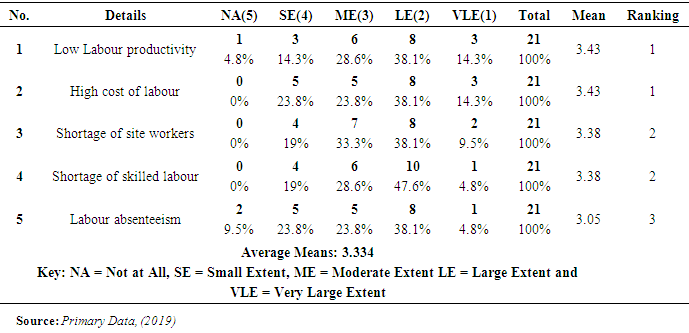 |
| |
|
The finding agrees with the findings in other countries by Rahman et. al., (2013); a mean of 3.43 implied that majority of the respondents believed that high cost of labour had a strong influence on cost deviation and was ranked 1st. The finding also agree with findings of Rahman et. al., (2013) conducted in Malaysia; a mean of 3.05 implied that majority of the respondents believed that labour absenteeism had a strong influence on cost deviation and ranked 3rd. This also agrees with the findings of Rahman et. al., (2013). Generally, the overall Average Means was 3.334 implying that majority of the respondents believed that the factor Labour Management is one of the major factors that influence the cost deviation within road maintenance projects within Uganda National Roads Authority.
4.2.6. Material and Machinery Related Factors
According to Table 10, a mean of 4.00 implied that majority of the respondents believed that fluctuation of prices of materials had a strong influence on cost deviation being ranked 1st. This agrees with the findings from other countries by Rahman et al., (2013); Ahmed et. al., (2014) and Omoregie and Radford (2016). Fluctuation of material prices, e.g. cement, steel, fuel, lubricants and gravels were reportedly very common within the region and was the main cause of negative cost deviations leading to poor cost performance. The mean of 3.81 implied that majority of the respondents believed that shortages of materials had a strong influence on cost deviation and was ranked 3rd in agreement with findings by Ahmed et. al., (2014); Omoregie and Radford (2016) and Otim et. al., (2013); a mean of 3.67 implied that majority of the respondents believed that late delivery of materials and equipment had a strong influence on cost deviation and was ranked 4th in agreement with other findings by Omoregie and Radford (2016); a mean of 3.86 implied that majority of the respondents believed that equipment availability and failure had a strong influence on cost deviation with a ranking of 2nd position. This also agrees with the findings by Alinaitwe et. al., (2013); Enhassi et. al., (2010); Otim et. al., (2013) and Tarimo 2017. Generally, the overall Average Means was 3.835 implying that majority of the respondents believed that the factor material and machinery is one of the major factors that influence cost deviation within road maintenance projects within Uganda National Roads Authority. The influence of materials and machinery factors was believed to be seen on the negative cost deviations in wearing course and shoulder costs for nine of the fourteen projects.Table 10. Descriptive statistics of Material and Machinery
 |
| |
|
4.2.7. Project Management and Contract Administration Related Factors
Findings in Table 11, a mean of 3.14 implied that majority of the respondents believed that poor project management had a strong influence on cost deviation and was ranked in 4th position. The finding agrees with that of Al- Agere and Al-Hassan (2016) and Omoregie and Radford (2006); a mean of 3.67 implied that majority of the respondents believed that change in the scope of the project had a strong influence on cost deviation and was ranked in 1st position. The finding agrees with findings from other countries by Ahmed et. al., (2014); Alinaitwe et. al., (2013); Aziz (2013); Chilese and Berko (2010) and Niazi and Painting (2017). The mean of 3.33 implied that majority of the respondents believed that delays in decision making had a strong influence on cost deviation and was ranked in the 3rd position. The finding also agrees with other findings by Omoregie and Radford (2006) and Otim et. al., (2013); a mean of 3.43 implied that majority of the respondents believed that inaccurate quantity take off had a strong influence on cost deviation and was ranked in 2nd position. The finding agrees with other findings by Aziz (2013) and Omoregie and Radford (2006).Table 11. Descriptive statistics of Project Management and Contract Administration
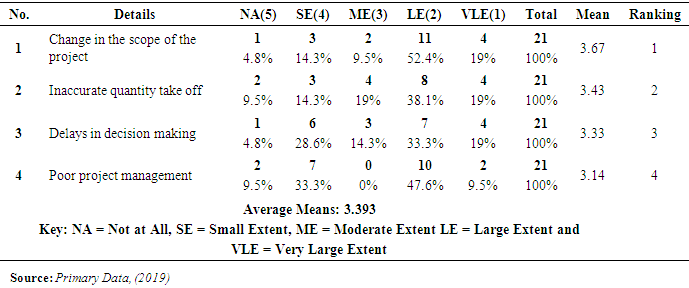 |
| |
|
Generally, the overall Average Means was 3.393 implying that majority of the respondents believed that the factor Project Management and Contract Administration is one of the major factors that influence cost deviation within Road Maintenance Projects within Uganda National Roads Authority.From table 12, it is apparent that the most important factor affecting cost performances of unpaved road maintenance work is material and machinery related factor and the least is design and documentation related factor. It can then be concluded that critical attention be paid to the problems under each of these factors when planning and implementing road maintenance budgets. This will contribute to the improvement of cost performances of the road maintenance projects. However, the researcher also concluded that information and communication technology (ICT) did not have any impact on cost deviations within road projects in UNRA hence can be ignored when developing cost estimates for maintenance road project.Table 12. Overall ranking of factors affecting Cost Performances
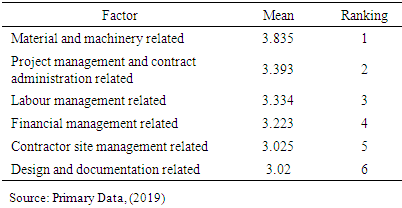 |
| |
|
5. Conclusions and Recommendations
Inaccurate estimation or calculation of unpaved road maintenance project costs are rampant due to inadequate consideration of factors affecting cost deviations. Fluctuation of prices of materials, equipment availability and breakdown are major factors that affect cost performances of road maintenance projects. There is good coordination, communication and a faster information flow between project parties of road maintenance projects in UNRA. There is need to give adequate time for planning and budgeting for Term / Periodic maintenance of unpaved roads so that accurate and realistic budgets are prepared to address the effects of cost performance factors which lead to negative cost deviations in the studied projects. Policy makers, organizations top managers and implementers of projects should put more focus on factors affecting cost performances of road maintenance projects when preparing and implementing project budgets. The researchers recommend that subsequent researches should examine the effect of project management style on project cost deviations.
ACKNOWLEDGEMENTS
We acknowledge and are grateful to the managers of Uganda National Roads Authority for considering and allowing this study to be conducted in the regional stations. We are thankful for the necessary information and data availed for the study.
References
| [1] | Ahmed,S., Dlask, P., and Hassan, B. (2014). Construction Maeconomic Conference. Faculty of Civil Engineering, Tishreen University, Lattakia, Syria. |
| [2] | Al-Agele H. K., A. J. Al-Hassan (2016). The reasons of costs deviation in the Iraqi construction projects. Field Assessment Department of Civil Engineering / College of Engineering / University of Baghdad, Iraq. |
| [3] | Alinaitwe H., Apolot R., and Tindiwensi D. (2013). Investigation into the causes of delays and cost overruns in Uganda’s public sector construction projects. Journal of Construction in Developing Countries. Vol.18 (2), pp. 33-47. |
| [4] | Amin, M. E. (2005). Social Science Research: Conception methodology and analysis. Kampala: Makerere University Printery. |
| [5] | Atkinson R. (1999). Project Management: Cost, time and quality, two best guesses and a phenomenon, it is time to accept other success criteria. International Journal of Project Management. Vol. 17(6), pp. 337-342. |
| [6] | Aziz R., F. (2013). Factors causing cost variation for constructing wastewater projects in Egypt; Alexandria Engineering Journal. Vol. 52(1), pp. 51-66. |
| [7] | Burnigham S., and Stankevich N., (2005). Why road maintenance is important and how to get it done. Transport Notes No. TRN4. The World Bank. Washington DC. |
| [8] | Cantarelli, C. C., Flyvbjerg, B, and Buhl, S. L. (2012). Geographical variation in project cost performance: The Netherlands versus Worldwide Journal of Transport Geography, Vol.24, pp. 324–331. |
| [9] | Chan S. (2014). Cost control: meaning, tools, techniques and estimation of cost control. Your article Library. https://0x9.me/zJwgK. |
| [10] | Enshassi, Arain, A., Al‐Raee, F., Sadi, (2010). Causes of variation orders in construction projects in the Gaza Strip; Journal of Civil Engineering and Management, Vol.16 (4), pp.540-551. |
| [11] | Guo-Li Y. (2010). Project time and budget monitor and control, Management Science and Engineering. Vol. 4, pp. 56-61. |
| [12] | Kothari, C. R. (2004). Research methodology. Methods and techniques. (2nd Ed). India. New Age. |
| [13] | Mahamid, I., and Amund, B. (2012). Cost deviations in road construction projects; case of Palestine. Australasian Journal of Construction Economics and Building, Vol.12 (1), pp. 58-71. |
| [14] | Mugenda, O., M. & Mugenda, A., G (1999). Research methods; qualitative and quantitative approaches. ACTS publishers, Nairobi, Kenya. |
| [15] | Ndihokubwayo, R. (2008). An analysis of the impact of variation orders on project performance; CPUT Theses & Dissertations http://works.bepress.com/rubenndihokubwayo/1. |
| [16] | Niazi, G., A. and Painting, N. (2016). Significant factors causing cost overruns in the construction industry in Afghanistan; 7th International Conference on Engineering, Project and Production Management; pp.1877-7058. |
| [17] | Oguya S.A., and Muturi, W, (2016). Factors affecting performance of road construction projects in arid and semi-arid areas in Kenya, International Journal of Social Sciences and Information Technology, Vol.2 (8). |
| [18] | Omoregie, A. & Radford, D., (2006). Infrastructure delays and cost escalations; causes and effects in Nigeria. Proceedings of the 6th International Postgraduate Research Conference in the Build and Human Environment. Delft University of Technology, 3-4 April. |
| [19] | Otim G., Nakacwa F., and Chakula M. (2011). Cost control techniques used on building construction sites in Uganda. Second International Conference on Advances in Engineering and Technology. |
| [20] | Otim, G., and Alinaitwe H., M. (2013). Factors affecting the performance of pavement road construction projects in Uganda. School of Built Environment / College of Engineering, Design, Art and Technology, Makerere University. Uganda. https://www.irbnet.de/daten/iconda/CIB_DC26254.pdf. |
| [21] | PIARC (World Road Association). 1994. International Road Maintenance Handbook: Practical Guidelines for Rural Road Maintenance, Volume I of IV. Roadside Areas and Drainage. Financed and coordinated by ODA and TR. |
| [22] | Washington State Department of Transportation (2015). Cost estimating manual for projects. M3034.03. www.wsdot.wa.gov/publications/manuals/fulltext/m3034/estimating guidelines.pdf. |




 Abstract
Abstract Reference
Reference Full-Text PDF
Full-Text PDF Full-text HTML
Full-text HTML










